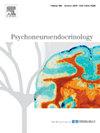脂质参数和抑郁与炎症调节作用之间的关系:87,636名英国生物银行参与者的网络分析
IF 3.4
2区 医学
Q2 ENDOCRINOLOGY & METABOLISM
引用次数: 0
摘要
背景:调查脂质与抑郁相关的研究报告了不一致的结果,很少有人考虑脂质参数之间的相互关系。此外,炎症在这些关联中的调节作用尚不清楚。本研究旨在(1)在控制其他脂质参数后评估血脂下降的相关性;(2)探索炎症的调节作用。该研究包括来自英国生物银行的87,636名参与者。在整个样本中构建了两两混合图形模型(MGM)网络,以检查七个脂质参数与抑郁症之间的潜在关联。通过以下方法探讨炎症的调节作用:(1)对按高敏c反应蛋白(hs-CRP)水平分层的组的MGM网络进行两两估计,(2)进行网络比较测试(nct),(3)构建调节网络模型(MNMs)。结果在全样本网络中,确定了甘油三酯(TG,边权= 0.034)、高密度脂蛋白胆固醇(HDL-C,边权=−0.011)、低密度脂蛋白胆固醇(LDL-C,边权=−0.009)和脂蛋白(Lp(a),边权= 0.012)与抑郁症的连接边。未升高和升高的hs-CRP网络在Lp(a) -抑郁边缘表现出相反的迹象。在nct中,hdl - c抑制和载脂蛋白A1 (Apo A1)抑制在边缘权重上存在显著差异。hs-CRP调节HDL-C、Apo A1和Lp(a)与MNMs抑郁的关系。结论在控制其他脂质参数后,总体研究人群中TG、Lp(a)与抑郁呈正相关,HDL-C、LDL-C与抑郁呈负相关。炎症调节HDL-C、Apo A1和Lp(a)与抑郁的关系。我们的研究为血脂与抑郁的关联提供了进一步的证据。本文章由计算机程序翻译,如有差异,请以英文原文为准。
Associations between lipid parameters and depression with the moderating role of inflammation: Network analyses of 87,636 UK Biobank participants
Background
Studies investigating lipid–depression associations have reported inconsistent findings, and few have considered the interrelationships among lipid parameters. Additionally, the moderating role of inflammation in these associations remains unclear. This study aims to (1) assess lipid–depression associations after controlling for other lipid parameters, and (2) explore the moderating effect of inflammation.
Methods
The study included 87,636 participants from the UK Biobank. A pairwise mixed graphical model (MGM) network was constructed in the entire sample to examine the prospective associations between seven lipid parameters and depression. The moderating role of inflammation was explored by: (1) estimating pairwise MGM networks for groups stratified by high-sensitivity C-reactive protein (hs-CRP) levels, (2) conducting network comparison tests (NCTs), and (3) constructing moderated network models (MNMs).
Results
In the full-sample network, edges connecting triglycerides (TG, edge weight = 0.034), high-density lipoprotein cholesterol (HDL-C, edge weight = −0.011), low-density lipoprotein cholesterol (LDL-C, edge weight = −0.009), and lipoprotein(a) (Lp(a), edge weight = 0.012) with depression were identified. The non-elevated and elevated hs-CRP networks exhibited opposite signs for the Lp(a)–depression edge. In NCTs, HDL-C–depression and apolipoprotein A1 (Apo A1)–depression showed significant differences in edge weights. hs-CRP moderates the associations of HDL-C, Apo A1, and Lp(a) with depression in MNMs.
Conclusions
After controlling for other lipid parameters, TG and Lp(a) are positively, while HDL-C and LDL-C are negatively associated with depression in the overall study population. Inflammation moderates the associations of HDL-C, Apo A1, and Lp(a) with depression. Our study provides further evidence for the lipid–depression associations.
求助全文
通过发布文献求助,成功后即可免费获取论文全文。
去求助
来源期刊

Psychoneuroendocrinology
医学-精神病学
CiteScore
7.40
自引率
8.10%
发文量
268
审稿时长
66 days
期刊介绍:
Psychoneuroendocrinology publishes papers dealing with the interrelated disciplines of psychology, neurobiology, endocrinology, immunology, neurology, and psychiatry, with an emphasis on multidisciplinary studies aiming at integrating these disciplines in terms of either basic research or clinical implications. One of the main goals is to understand how a variety of psychobiological factors interact in the expression of the stress response as it relates to the development and/or maintenance of neuropsychiatric illnesses.
 求助内容:
求助内容: 应助结果提醒方式:
应助结果提醒方式:


